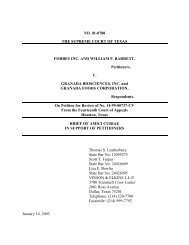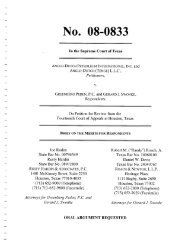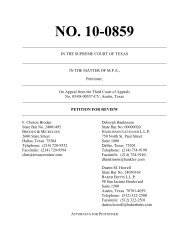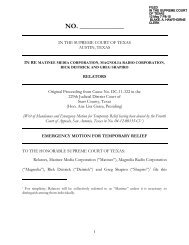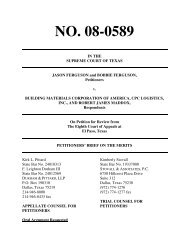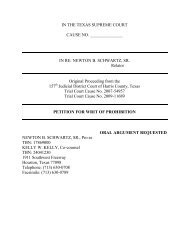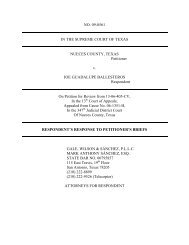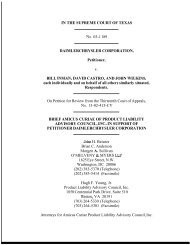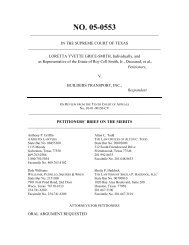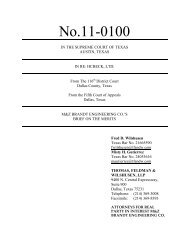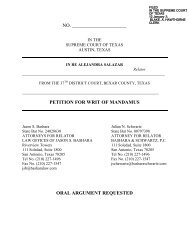Petitioner's Brief on the Merits - Supreme Court of Texas
Petitioner's Brief on the Merits - Supreme Court of Texas
Petitioner's Brief on the Merits - Supreme Court of Texas
Create successful ePaper yourself
Turn your PDF publications into a flip-book with our unique Google optimized e-Paper software.
when retirement precedes divorce, courts and litigants have a much easier analysis before<br />
<strong>the</strong>m.<br />
The Marriage, Employment, Retirement, Divorce sequence <strong>of</strong> events is <strong>the</strong> simplet<br />
scenario, as <strong>the</strong> entire value <strong>of</strong> <strong>the</strong> retirement benefit is earned entirely during <strong>the</strong> marriage<br />
and is thus all community property at divorce. Dividing benefits, as paid, by <strong>the</strong> percentage<br />
<strong>of</strong> community property awarded <strong>the</strong> alternate payee as part <strong>of</strong> <strong>the</strong> just and right divisi<strong>on</strong><br />
(<strong>of</strong>ten 50%) accurately divides <strong>the</strong> community interests for ei<strong>the</strong>r a defined c<strong>on</strong>tributi<strong>on</strong> or<br />
a defined benefit plan. 66<br />
The Taggert formula when properly applied provides a reas<strong>on</strong>able estimate <strong>of</strong> <strong>the</strong><br />
community interest in retirement benefits. The Employment, Marriage, Retirement,<br />
Divorce sequence <strong>of</strong> events creates a period <strong>of</strong> separate property benefits, followed by <strong>the</strong><br />
community property interest. For defined benefit plans in this fact situati<strong>on</strong>, <strong>the</strong>re are no<br />
problems with being unable to accurately value <strong>the</strong> retirement benefits at divorce. The <strong>on</strong>ly<br />
calculati<strong>on</strong> necessary is to apporti<strong>on</strong> <strong>the</strong> benefits to segregate out <strong>the</strong> community property<br />
share by applying <strong>the</strong> Taggert formula. 67<br />
The amount an alternate payee would receive,<br />
assuming <strong>the</strong> trial court orders that ½ is a just and right divisi<strong>on</strong> <strong>of</strong> <strong>the</strong> community share, is:<br />
½<br />
[share <strong>of</strong><br />
community<br />
property]<br />
X<br />
Years in marriage<br />
Years <strong>of</strong> employment<br />
Prior to divorce<br />
[apporti<strong>on</strong>ment <strong>of</strong><br />
community property]<br />
66 Often, benefits do not commence for some period <strong>of</strong> time after retirement. In <strong>the</strong> case <strong>of</strong> a defined c<strong>on</strong>tributi<strong>on</strong><br />
plan, however, <strong>the</strong> participant’s account will <strong>of</strong>ten be segregated up<strong>on</strong> divorce, and subsequent earnings and losses<br />
are allocated separately. This is particularly <strong>the</strong> case when a defined c<strong>on</strong>tributi<strong>on</strong> plan permits participants (and<br />
alternate payees) to designate <strong>the</strong>ir own investment opti<strong>on</strong>s.<br />
67 See Albrecht, 974 S.W.2d at 263 (<strong>the</strong> Taggert formula is used when <strong>the</strong> value <strong>of</strong> <strong>the</strong> plan is not at issue).<br />
X<br />
Accrued<br />
benefit at<br />
divorce<br />
[community<br />
property]<br />
36




